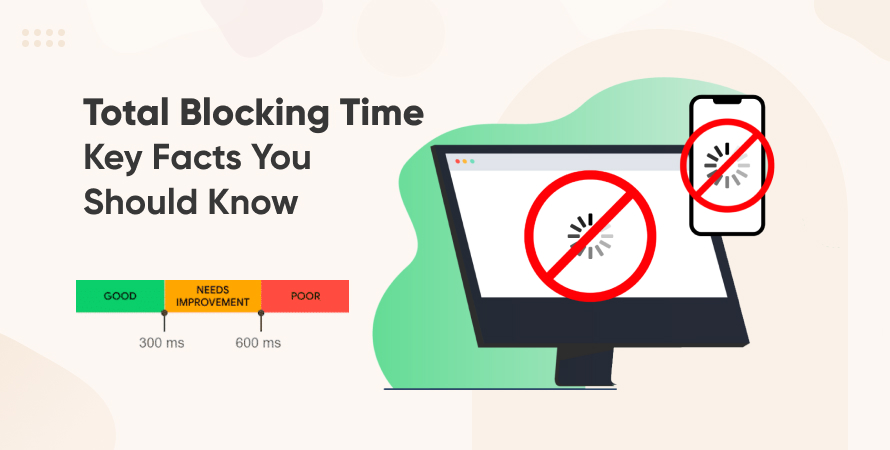Total Blocking Time (TBT) – Key Facts You Should Know



Introduction
In today’s competitive digital landscape, speed is not just a technical metric—it’s a business imperative. A slow or unresponsive website can drastically affect user experience, conversion rates, and even search engine rankings. This is why Google introduced Core Web Vitals, a set of performance metrics that evaluate real-world user experience on websites.
Among these metrics, Total Blocking Time (TBT) plays a crucial role in understanding how long a site remains unresponsive to user input during its loading phase. Although less known than metrics like Largest Contentful Paint (LCP), TBT has a significant impact on both performance and SEO. Whether you’re a web developer, a business owner, or part of a digital marketing agency, understanding TBT can give you the edge in optimizing your site’s interactivity and responsiveness.
This blog will dive deep into the meaning of TBT, how it works, what causes high TBT, and what you can do to reduce it. We’ll also compare it with similar metrics like FID and INP, highlight measurement tools, and provide actionable solutions based on real-world scenarios.
Definition of TBT
TBT stands for Total Blocking Time. It measures the total amount of time between First Contentful Paint (FCP) and Time to Interactive (TTI) during which the main thread is blocked for long enough (more than 50 milliseconds) that it can’t respond to user input.
TBT Definition and Explanation
TBT means the total duration of all “long tasks” that block the browser’s main thread. A “long task” is defined as any task that takes more than 50 ms to execute. During these long tasks, if a user tries to interact with the page—like clicking a button, opening a menu, or typing into a form—the browser can’t respond until the task finishes.
Think of it this way: if your website’s main thread is a cashier at a store, TBT measures how much time the cashier spends doing paperwork instead of attending to customers. The more time spent away from helping, the longer the customer waits—and the worse the experience becomes.
T.B.T is measured in milliseconds (ms), and a low TBT means your site is fast and responsive, while a high TBT indicates delays and lag.
Why TBT Matters for SEO and User Experience
TBT isn’t just a technical metric—it’s a direct reflection of how usable your website is during its most critical phase: the initial load. Google emphasizes user experience in its ranking algorithm, and Core Web Vitals, including TBT, are a big part of that.
SEO Impact
High TBT can indirectly hurt your search engine optimization (SEO) by increasing bounce rates and reducing engagement. Google interprets these signals as a poor experience, leading to potential drops in rankings.
Business Impact
If your website is slow to respond, visitors may leave before they even see what you offer. For digital marketing agencies, addressing TBT is not just about ticking a box—it’s about ensuring the funnel is smooth from click to conversion.
TBT vs FID vs INP – Understanding the Differences
As Google’s metrics have evolved, developers and marketers need to understand how TBT, FID (First Input Delay), and INP (Interaction to Next Paint) differ—and how they work together.
| Metric | What It Measures | Type of Data | Importance |
|---|---|---|---|
| TBT | Total time the main thread is blocked | Lab data | Key for diagnosing performance issues |
| FID | Delay in response to first user interaction | Field data | Reflects real user input delay |
| INP | Overall responsiveness across interactions | Field data | Replaces FID in Core Web Vitals from 2024 |
While TBT is a lab metric, it correlates closely with FID and INP. Improving TBT is often the most reliable way to enhance real-world responsiveness, making it especially useful during development and testing.
What Causes High TBT?
There are several culprits behind a high TBT score, many of which stem from inefficient JavaScript handling and rendering processes. Understanding these causes is the first step in optimization.
1. Heavy JavaScript Execution
Large JavaScript bundles or unnecessary libraries can choke the main thread. The browser must parse, compile, and execute all of this before it can respond to users.
2. Third-Party Scripts
Analytics tools, ads, and widgets can be incredibly heavy. Some run long tasks that block the main thread, especially if they’re not asynchronous.
3. Framework Overhead
Frameworks like React, Angular, or Vue are powerful—but they can introduce complexity that results in high TBT if not managed correctly.
4. Inefficient Rendering
Unoptimized DOM manipulation or CSS reflows can cause rendering bottlenecks that prevent interactivity.
5. Time Blocking Website Issues
Some websites unintentionally block critical resources or run background processes that monopolize the main thread. This can include cookie banners, live chat widgets, or complex animations.
How to Measure TBT Effectively
Measuring TBT accurately requires a combination of lab testing tools and real-user monitoring. Here are the most reliable ways to measure it:
Lighthouse (Chrome DevTools)
Lighthouse provides a lab-based TBT score with diagnostics on what’s causing delays. It’s ideal for development and debugging.
PageSpeed Insights
This tool uses Lighthouse under the hood but adds field data from the Chrome User Experience Report. It offers a balance between lab and real-world performance insights.
WebPageTest
Provides detailed breakdowns and visualization of thread blocking, giving developers granular insights into performance bottlenecks.
Chrome DevTools Performance Panel
Use this to analyze thread activity and identify which scripts are blocking the main thread.
Proven Strategies to Reduce Total Blocking Time
Improving TBT often comes down to reducing main-thread work. Here are specific, proven techniques:
1. Break Up Long Tasks
Split heavy JavaScript functions into smaller asynchronous chunks. This prevents main thread blocking, improves responsiveness, and enhances the overall perceived performance during the critical page load phase.
2. Minimize JavaScript
Reduce the size of JavaScript by tree-shaking unused code, minifying files, and eliminating unnecessary libraries. Load only the scripts required for each page to improve load efficiency.
3. Code Splitting
Use code splitting to divide large JavaScript bundles into smaller, more manageable chunks. Load these only when needed, improving initial page load times and reducing Total Blocking Time significantly.
4. Use Web Workers
Offload resource-intensive tasks like data processing or complex calculations to Web Workers. This keeps the main thread free, enabling faster responses to user inputs during page interaction.
5. Optimize Third-Party Code
Review all third-party scripts, removing those that don’t contribute to key functionality. Defer or asynchronously load non-critical ones to prevent them from blocking the main thread during loading.
6. Lazy Load Non-Essential Elements
Implement lazy loading for images, videos, and scripts not immediately visible. This reduces the initial workload on the main thread and shortens TBT, enhancing perceived page speed.
Tools and Resources for Developers & Marketers
For developers and marketers alike, the following tools can guide your TBT optimization journey:
- Lighthouse (for lab diagnostics)
- Chrome DevTools (thread analysis)
- WebPageTest (performance audits)
- GTmetrix (user-friendly performance reports)
- Core Web Vitals Extension (real-time testing)
- Online communities like web.dev and Stack Overflow
Marketers should work closely with developers to align performance fixes with UX and campaign objectives. For digital marketing agencies, this synergy is often the difference between a technically sound and commercially successful website.
Common Myths About TBT
“TBT only affects developers”
Wrong. Total Blocking Time directly impacts user experience, increasing bounce rates and reducing engagement. It’s not just a developer metric—it affects SEO, usability, and overall website effectiveness.
“TBT isn’t relevant anymore with INP”
False. While INP is a newer field metric, TBT remains vital during development. It helps identify long tasks and optimize interactivity before issues appear in real-user environments.
“Eliminating scripts is the only fix”
Not true. Reducing Total Blocking Time doesn’t require removing all scripts. Instead, smart optimization—like deferring non-critical code, using lazy loading, and splitting bundles—can significantly improve performance without sacrificing functionality.
How Digital Marketing Agencies Approach TBT
Performance is no longer a developer-only concern. Digital marketing agencies are increasingly integrating technical SEO and performance audits into their workflow. This holistic approach allows agencies to:
- Audit for performance bottlenecks
- Translate metrics like TBT into business outcomes
- Provide clients with data-backed recommendations
- Optimize user journeys from first impression to conversion
By focusing on Core Web Vitals like Total Blocking Time, agencies not only improve rankings but also enhance ROI for their clients.
Conclusion
Total Blocking Time is one of the most actionable and insightful metrics in web performance. It tells you whether your website is interactive—or stuck in a loading limbo when users need it most. A high TBT can drag down user satisfaction, SEO rankings, and conversion rates.
If you’re a site owner, developer, or part of a digital marketing agency, understanding and reducing TBT should be part of your web strategy. From breaking up long tasks to optimizing JavaScript and auditing third-party scripts, there are numerous ways to enhance TBT and elevate the user experience.
Want expert help to improve your site’s Core Web Vitals? Hire Core Web Vitals consultants today to ensure your website is fast, responsive, and built for success.
Frequently Asked Questions (FAQs)
TBT, or Total Blocking Time, measures the total duration during which a website’s main thread is blocked and unable to respond to user input. It reflects how interactive a site is during load.
TBT is a lab metric used during development, while FID and INP are field metrics that measure real-user interaction delays. TBT helps diagnose the root cause of poor FID/INP scores.
Google recommends a TBT of less than 200 milliseconds. Anything above this may indicate performance issues that can hurt user experience and SEO.
Yes. While not a direct ranking factor, high TBT affects Core Web Vitals, which are part of Google’s page experience signals. Poor performance can indirectly reduce rankings.
Use Lighthouse, PageSpeed Insights, WebPageTest, and Chrome DevTools to measure and analyze TBT. These tools offer actionable insights into what’s causing delays and how to fix them.